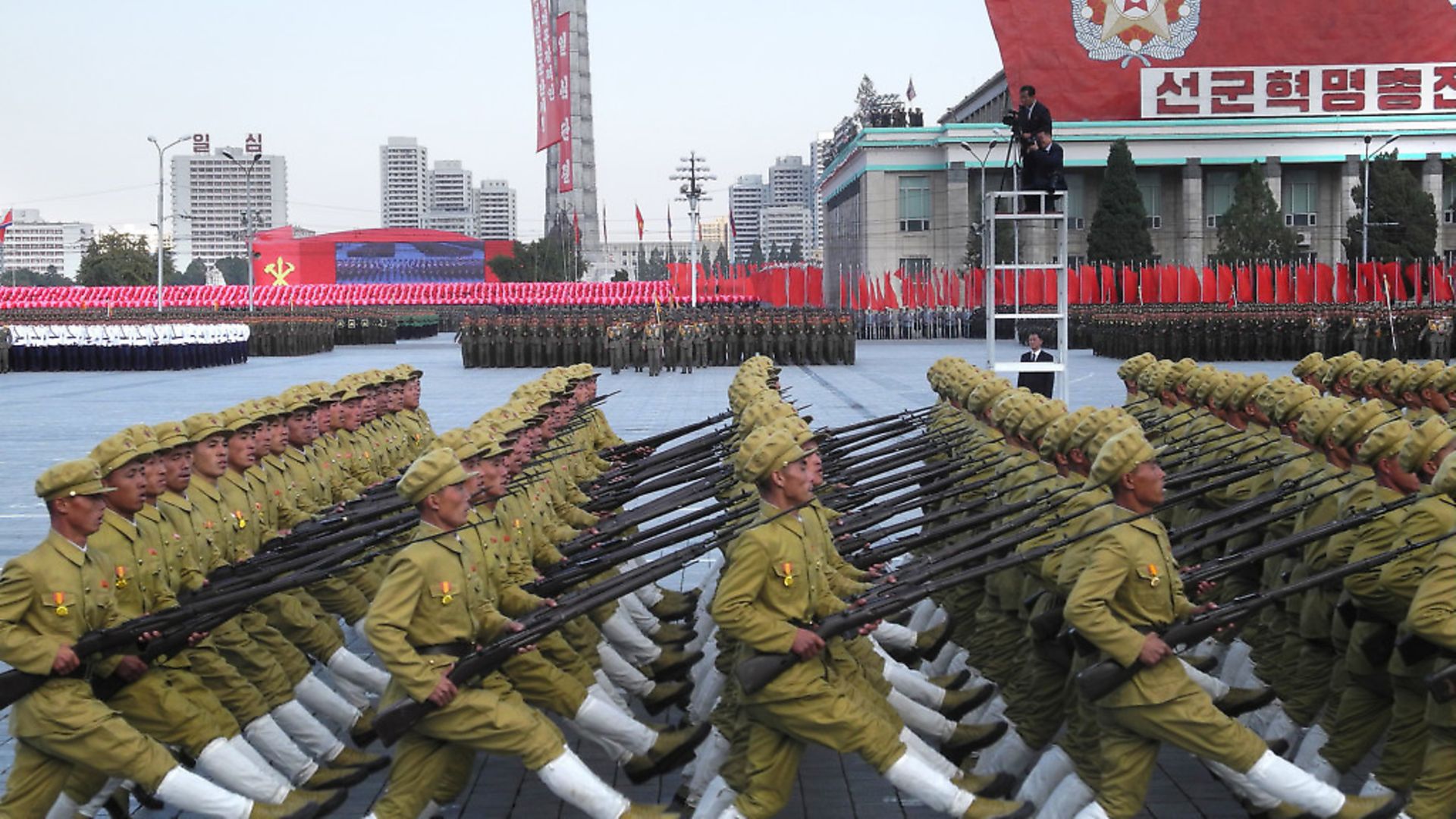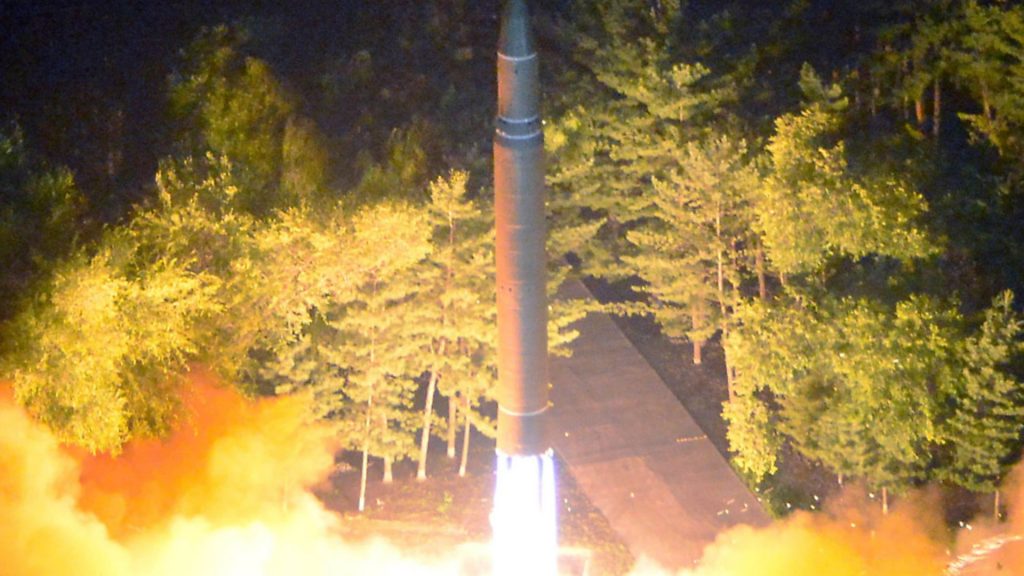
Trump, with his appetite for diversionary tactics, could see a pre-emptive strike against North Korea as the ultimate diversion from his domestic problems

‘The Fake News Media will not talk about the importance of the United Nations Security Council’s 15-0 vote in favour of sanctions on N Korea!’
So went one of Donald Trump’s early morning Twitter rockets fired from his New Jersey holiday golf retreat, launched shortly before the balloon went well and truly up in his war of words with Pyongyang.
It left you wondering what planet this POTUS is living on. Almost every major news organisation around the world – including the president’s usual ‘fake news’ targets – had heavily reported that unanimous UN vote which imposed draconian economic sanctions against Pyongyang and was backed by both Russia and China.
Even as the president tweeted, over 48 hours after the vote, it was still topping Google’s most read story list. This was the Korea crisis through the prism of Trump, though – detached from reality, unpredictable. So was it a sign of total, delusional ignorance by the most powerful man on earth, or something far more cynical and dangerous?
With the world holding its breath over the escalating tension between theMad US and North Korea in the wake of its latest sabre-rattling inter-continental missile tests and boasts of being able to ‘annihilate’ mainland US cities, that is a burning and legitimate question.
Not least because of the two central characters in this melodrama, with its undertones of a Dr Strangelove plot revisited.
On one side, a narcissistic, impulsive US president who has hinted more than once that he’d be prepared to take the military option to destroy North Korea’s military ambitions.
On the other Kim Jong-un, volatile dictator of one of the world’s poorest, but most dangerous nations; a ruler whose ‘supreme leader’ authority depends on a combination of brutal, murderous repression and enslaving his people through the carefully-cultivated image of a ‘patriotic demigod’.
If there is one place on earth where a miscalculation or an egomaniac power play could unleash a nuclear holocaust it is the Korean peninsula. More dangerous by far than the crises in Syria, Iraq, Afghanistan or the terrorist threats posed by ISIS.
The 1950-53 Korean War, lest we forget, is actually still on. It was settled by a truce and never ratified by a peace treaty and has left the two sides facing each other across the 38th Parallel demilitarised zone (DMZ) ever since.
A point well-made by the far from sensationalist magazine The Economist with a cover story headlined ‘It could happen’, illustrated by a mushroom cloud carrying the faces of Trump and Kim.
As The Economist accurately flagged up: ‘The most serious danger is not that one side will suddenly try to devastate the other. It is that both sides will miscalculate, and that a spiral of escalation will lead to a catastrophe that no one wants.’
The ‘Miscalculation Factor’ comes with the kind of rhetoric being displayed by both maverick leaders. Donald Trump insists he’ll stop North Korea from perfecting a nuclear warhead that can devastate major US cities. ‘It won’t happen,’ POTUS has tweeted several times.
That was nothing, though, compared with his declaration that any more threats from Pyongyang will be met with ‘fire and fury like the world has never seen’.
That rhetorical groundstrike followed claims that the Kim regime had made a significant breakthrough in its quest to develop a small enough nuclear warhead to be fitted to its ICBM missiles. If reports are accurate it could, say some analysts, reduce estimates of North Korea’s ability to hit US cities with a nuclear strike from 5-10 years to 2-3 years.
It was followed, in classic escalation, with a North Korean claim to be ‘carefully examining’ a plan to launch a ballistic missile strike on the US Pacific island of Guam, home of one of America’s key military installations, the Anderson Air Force Base.
According to some US analysts, Trump has already consulted Pentagon chiefs on the feasibility of shooting down future North Korean missile test launches, either in flight or by striking at Kim Jong-un’s various launch sites. He has also reputedly asked about the possibility of cross-border military intervention to topple the Kim regime – a strategy guaranteed to trigger a second Korean War with catastrophic consequences that would dwarf the first.
Realistically, none one of these ‘options’ look very promising, of course, and Pentagon chiefs have told the White House exactly that. But there remains genuine concern that an unpredictable gung-ho president, especially one desperate to divert attention from his escalating domestic problems and plunging poll ratings, might not take heed if Kim Jong-un continues to bait him with continuing missile tests and blood-curdling rhetoric.
Just as alarming, for cooler Washington heads, is that Trump’s aggressive talk will backfire, convincing the North Korean leader that his regime is in immediate jeopardy and forcing him into what he sees as a pre-emptive strike.
In a near inversion of the last Korean War, the best bet for restraining an impulsive POTUS lies with the top generals who now represent the ‘sanity brigade’ in the generally chaotic Trump administration.
Chief of Staff John Kelly, Defence Secretary Jim ‘Mad Dog’ Mattis and National Security Adviser HR McMaster are a trio of experienced former generals, and all are respected as coming from the ‘intellectual flank’ of the US military.
They know only too well that Kim Jong-un’s missile launchers are scattered widely, buried deeply and heavily guarded and don’t make for easy targets. By the same token, they are well aware that neither the Pentagon nor US intelligence services are well-served with reliable intelligence sources inside North Korea, and that also applies to America’s South Korean allies too.
Above all, the generals, the Pentagon and US intelligence chiefs are tuned in to the latest strategic reports estimating that in the first 40 days of a conventional war between North and South, around 300,000 and 500,000 casualties would be suffered by South Korea forces and their US military allies based there. Among the civilian population in the South, the figures would run into hundreds of thousands dead. Such is the power of Kim Jong-un’s heavy artillery alone to rain down hell on earth on South Korea’s capital Seoul, population 10 million.
And if Trump were to resort to a nuclear strike against the Pyongyang regime, those same statisticians estimate the death toll would exceed 2.3 million, with over 600,000 badly injured and four million people on both sides of the DMZ, including US military personnel, affected by radioactive poisoning.
Any pre-emptive strike by Trump would also lead to a wider conflagration. Despite their support for tougher economic sanctions, neither Russia nor China would remain sanguine about such a move in the near future. Although the Chinese see the Kim Yong-un regime as an ill-behaved and troublesome neighbour and ally, they would be likely to stage their own military response to any unilateral US action.
Little wonder, then, that – despite the welter of sabre-rattling and threats of war – US Secretary of State Rex Tillerson is still publicly offering an olive branch to Kim and strongly arguing the case for a diplomatic solution. ‘When the conditions are right, then we can sit down and have a dialogue about the future of North Korea, so they can feel secure and prosper economically,’ he says.
Meanwhile, as Trump sounds off about ‘fiery’ retribution, diplomats and US intelligence officials will be quietly signalling to Moscow and Beijing that America isn’t on the brink of triggering a second Korean war. The White House will also come under pressure not to overreact by its South Korean and Japanese allies who, despite their deep concern at the apparent North Korean nuclear breakthrough, realise the catastrophic consequences of Trump ordering any major US military response.
As one senior Pentagon analyst put it to me: ‘You’ve got to realise that, no matter how worrying this development is, we’re still some way from Kim Yong-un being able to deliver any form of nuclear Armageddon. This is still very much a propaganda power play and the White House would be foolish to rush into taking the military option and abandoning the combined sanctions/diplomatic pressure route. Go down the former road and we’ll lose the unanimous international support achieved at the UN Security Council only last week and head into the biggest international crisis since, say, the Cuban missile showdown or the Vietnam and Korean wars. A war of words sounds terrifying, but it’s manageable. The real thing won’t be.
‘The reality is that Kim Jong-un is ramping up a propaganda war and provoking Trump as a reaction to the UN sanctions decision rather than seriously about to stage a strike. Yes, Kim is a bloody dictator, but, contrary to popular myth, he’s not actually a suicidal mad man either. If you examine the latest Pyongyang statements carefully, you’ll see the Korean People’s Army version talked about immediate ‘enveloping fire’ engulfing Guam, but the state news agency’s version was more nuanced, talking about a pre-emptive operation if the US ‘shows signs of provocation’.’
That said, these are incalculably high stakes and the huge fear remains that a miscalculation by either leader – Kim or Trump (both wildly unpredictable, impulsive personalities, they make natural foes) – could tip the Korean peninsula into a devastating conflict. For that reason, Pentagon analysts are pinning considerable hope on China stepping up the diplomatic pressure on Kim Yong-un, or even threatening its own military intervention. How Trump’s hectoring of its ally Pyongyang will encourage this is not clear.
But there is another underlying fear also panicking many on Capitol Hill, and beyond. That is Trump, with his appetite for diversionary tactics, could see a pre-emptive strike against North Korea as the ultimate diversion from his domestic problems, not least the escalating Russian Connection investigations.
As a senior Democrat put it to me: ‘Donald Trump might not be much of a political historian. But he does know that military conflict can – in the short-term – rally support around an unpopular president. Take 9/11 and President Bush, for example. The temptation to strike first and argue he’s doing it to save the American mainland from an exaggerated immediate threat from Kim Yong-un’s ICBMs must be very appealing for an impulsive president desperate to try and rally popular support at home ….and risk an incendiary international confrontation to do it.’
Paul Connew is a media commentator, broadcaster, author and former Sunday Mirror editor









